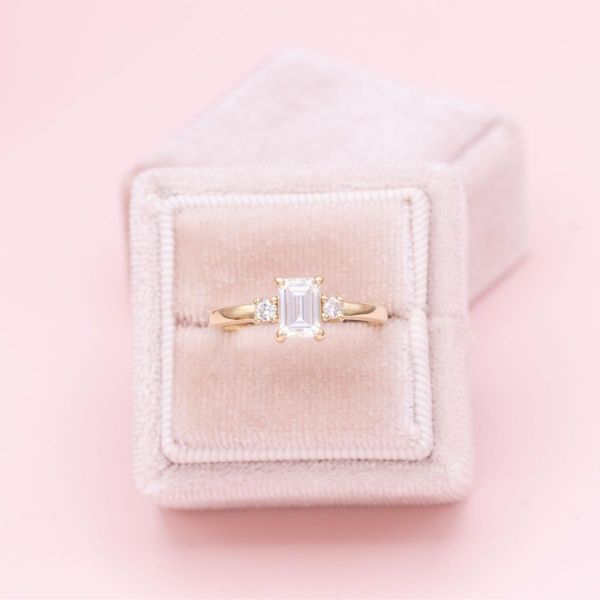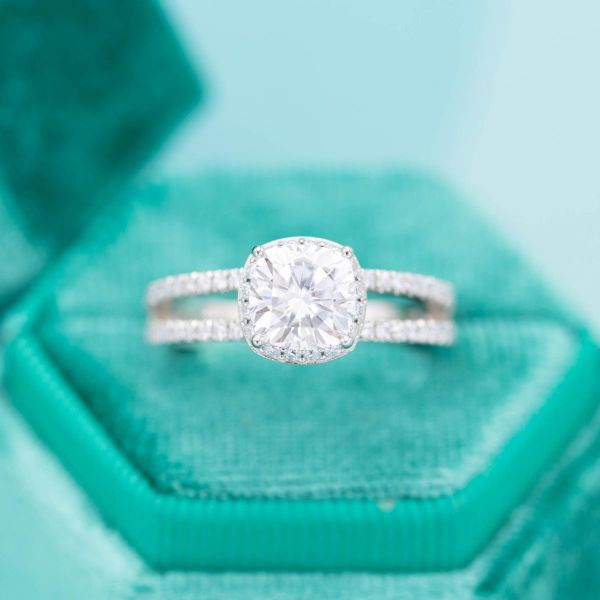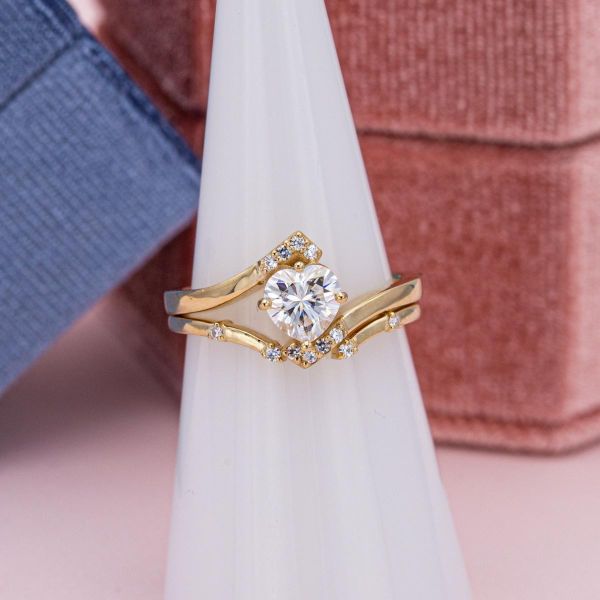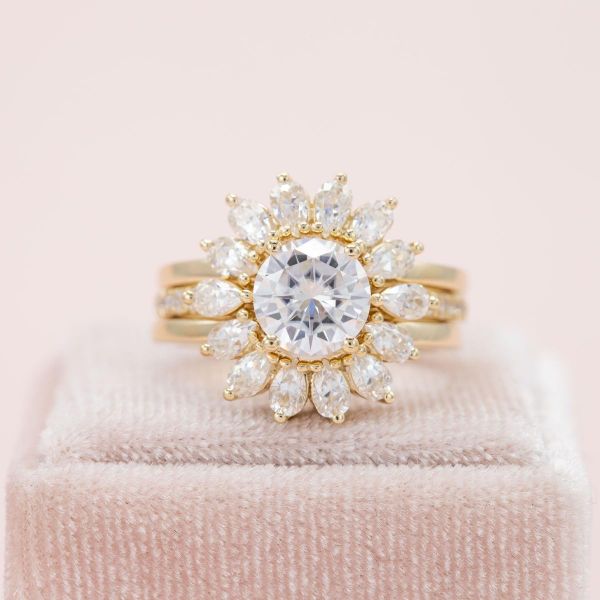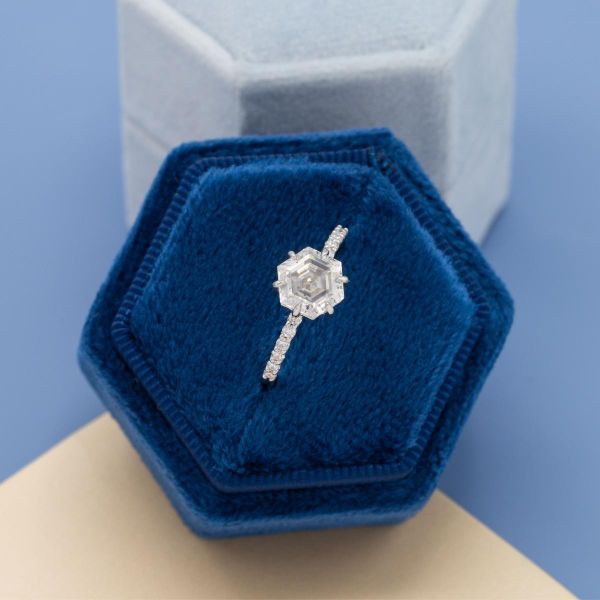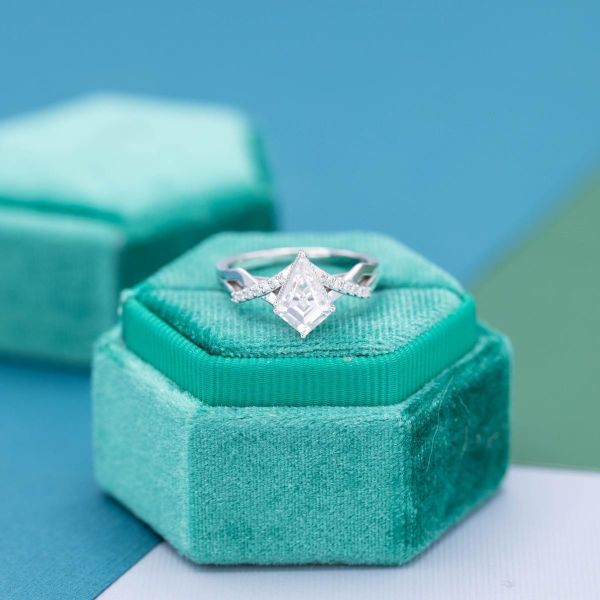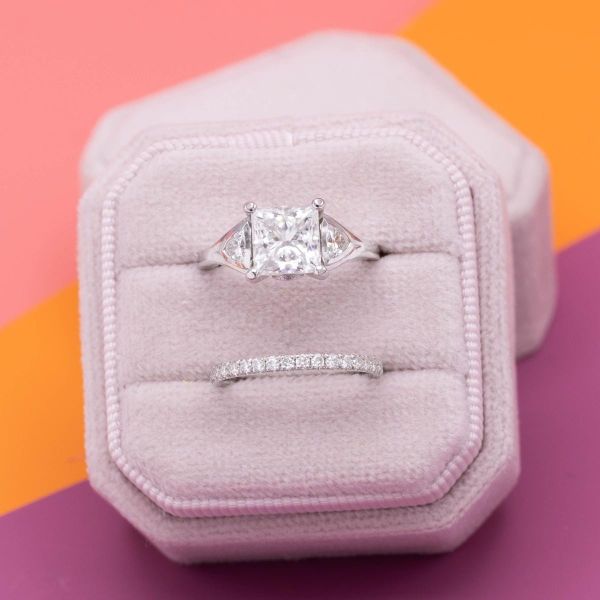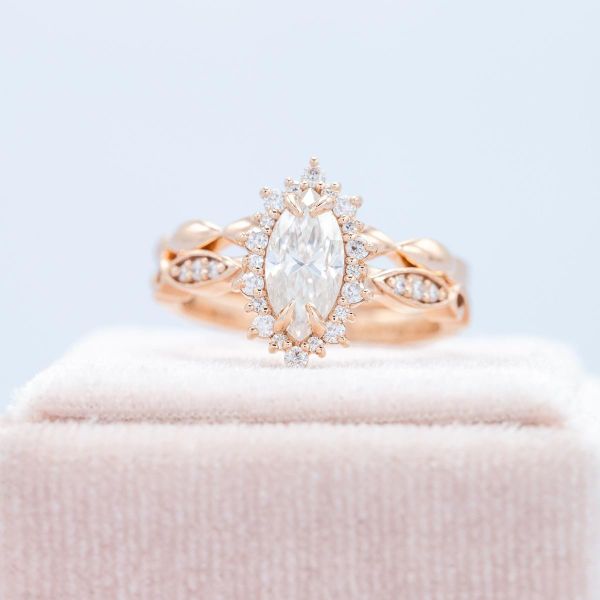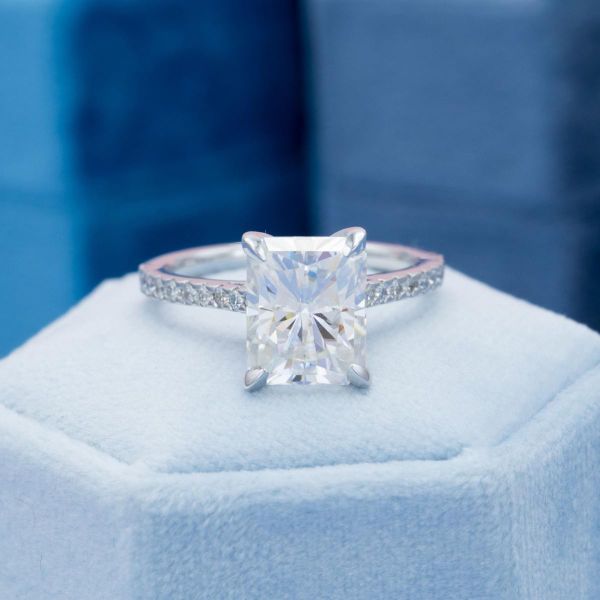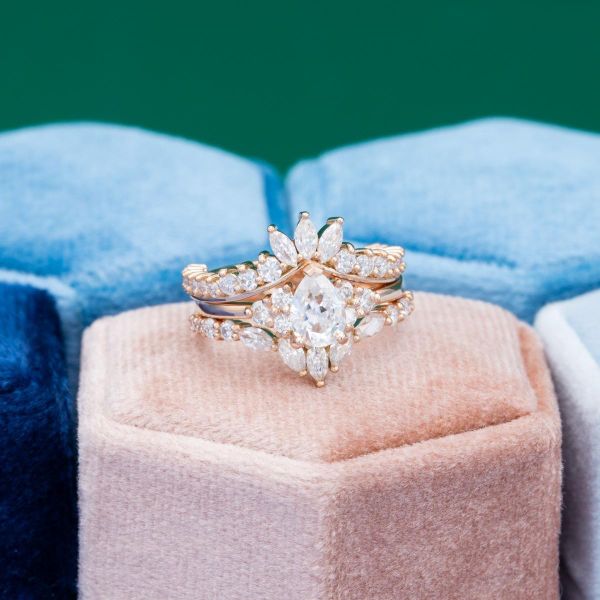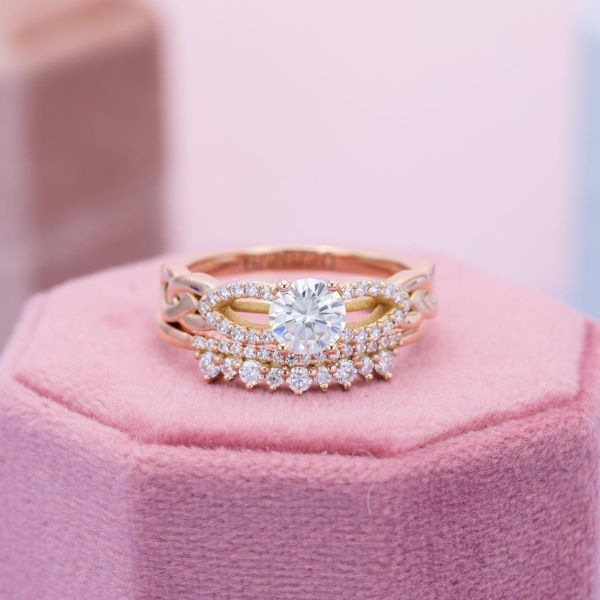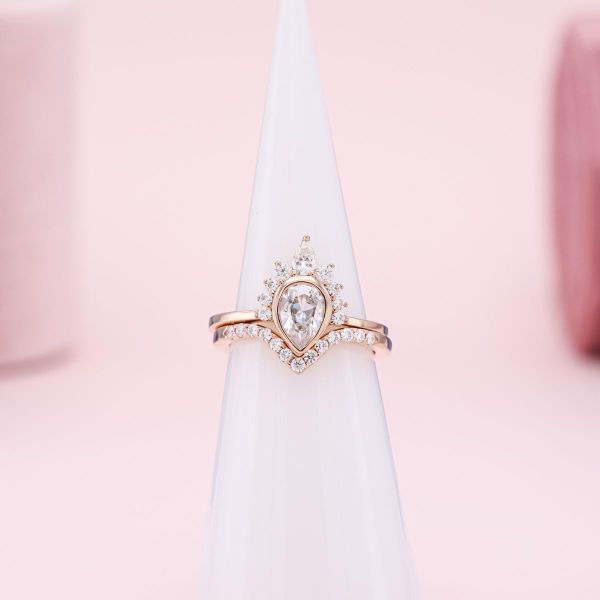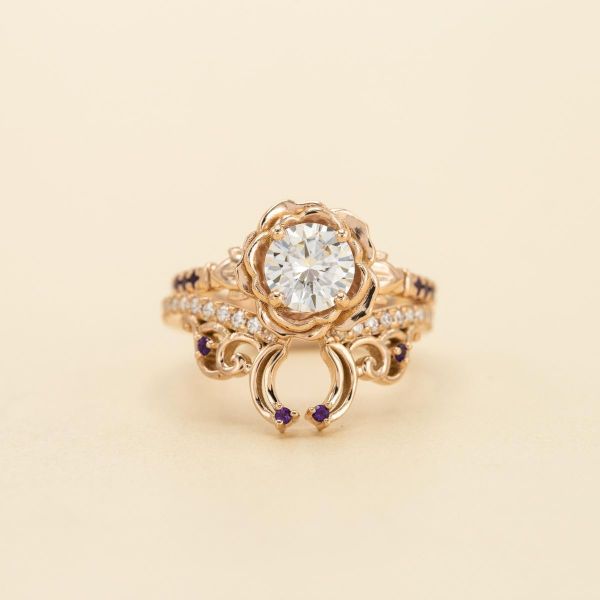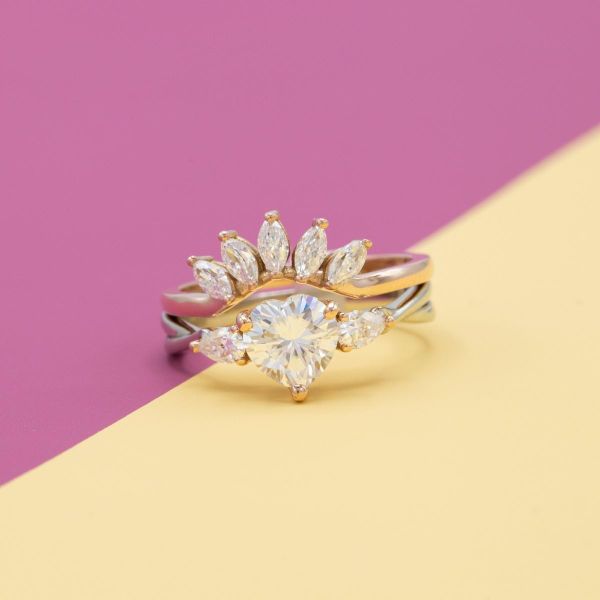Diamond alternatives
How to pick the perfect moissanite
Helpful tips for choosing your perfect moissanite
Choosing your ideal moissanite
So you’ve chosen moissanite as a center stone and are ready to create the ring of your dreams. Great! Durable, eco-friendly, and lab-created, moissanite is a solid choice for anyone seeking a sparkling white stone for their engagement ring. And unlike diamonds—which you need to assess for color, cut, and clarity—you’re pretty much guaranteed to get a glittering stone every time if you shop for high-quality branded moissanite. So, let’s dive into the specifics of choosing your ideal moissanite, particularly shape, cut, and size!
Fire, color, and clarity
Before we get started with the more personal aspects of choosing your perfect moissanite, let’s briefly recap three of the characteristics responsible for the sparkle that makes moissanite so unique: fire, color, and clarity.
If you’re set on moissanite, you probably know already that its fire exceeds that of diamond and is probably one of the reasons you decided to choose this sparkly stone. After all, what’s moissanite without that signature, colorful fire?
We already dove into the specifics of moissanite’s fire, but let’s do a little refresher course. When colorless stones like diamond and moissanite sparkle, they give off white light (brilliance) and colored light (fire). Where diamonds are famous for their brilliance, moissanite is known for its sparkly rainbow fire.
Because most moissanite on the market today is high quality, you really don’t have to worry about finding one that gives off the highest levels of fire—they all do! High-quality branded moissanites will have similar properties, which means you can pay more attention to the shape and size of your stone (more on that later!).
When it comes to color, gemologists assess moissanites on the same color scale as diamonds, which receive grades ranging from D (Colorless) to Z (Light Color). Moissanite’s color grades are broken down into three easy categories based on their (lack of) color:
- DEF: Colorless
- GHI: Near-Colorless
- JK: Faint Color
Don’t sweat too much over moissanite’s color, as most options you’ll find will be in that colorless (DEF) range. And all of the moissanites we use are colorless, so you can be sure your stone will have a bright, clear sparkle for plenty of “oohs” and “ahhs” from family and friends!
Finally, clarity is a big deal for a diamond, but it’s less crucial when you’ve chosen moissanite for your engagement ring. Similar to color, gemologists use the same clarity scale for moissanites as they do for diamonds. Each grade indicates a stone’s inclusions, accounting for type, size, amount, and visibility:
- FL: Flawless
- IF: Internally Flawless
- VVS1 and VVS2: Very Very Slightly Included
- VS1 and VS2: Very Slightly Included
- SI1 and SI2: Slightly Included
- I1, I2, and I3: Included
The most important factor for clarity is that inclusions aren’t visible to the naked eye, and this is always the case for our moissanites—they range from Internally Flawless (IF) to Very Slightly Included (VS1). This means they are eye clean with no visible inclusions, and the teeny tiny ones they might have won’t impact what your moissanite looks like unless you plan to stare at it under a microscope!
Shape and cut
Choosing a shape and cut for your moissanite is a matter of personal preference, but it’s one of the most exciting decisions to make! Because moissanite is lab-created and has a high clarity grade, it can be made into pretty much any shape imaginable in both brilliant and step cuts. Some shapes are more popular than others, but moissanite gives off a high level of fire and brilliance in almost every silhouette.
The most popular shape for moissanite is (drumroll, please!): the round brilliant. This shape and cut is designed specifically to promote sparkle, and its 58 facets enhance fire, brilliance, and scintillation. Similar to diamonds, moissanites sparkle the most in the round brilliant shape, and this is where you can also get the most exquisite fire.
The main difference you’ll find from shape to shape is how a moissanite sparkles in that particular cut. For instance, round, marquise, and princess cut moissanites have a brilliant cut which creates a prismatic, “crushed ice” sparkle. On the other hand, step cut styles like emerald and baguette have broader silhouettes—think square, rectangle, or octagon—and longer, mirror-like facets. These shapes give your stone depth and produce on/off flashes of light that are more subtle than the fractal sparkle of a brilliant cut.
Another way to choose a stone shape is by thinking about your ideal setting. Do you want a modern look or a vintage vibe? Round brilliants are timeless and suit all settings, whereas step cuts like emerald, baguette, and Asscher are perfect for antique looks. And brilliant cuts like marquise, pear, princess, and oval look amazing in contemporary settings!
So are you a round brilliant babe or a step cut emerald empress? Think about the amount of sparkle you wish to see from your moissanite and be sure to look at plenty of examples of each shape. That way, you can get a feel for the varied sparkle each one offers and choose accordingly!
Size
Did you know? Carat is a unit that measures weight, not size! So if you lined up a group of 1 carat diamonds, moissanites, colored stones, etc., you'd notice a slight size difference between them.
Most of us are familiar with the term “carat” or “carat weight”, and we tend to associate it with the size of a diamond. So when it comes to moissanite, the higher the carat, the larger the stone, right? Sure, but just don’t expect the exact same size from a 1 carat moissanite that you’d expect from a 1 carat diamond! A 1 carat moissanite will actually be a bit bigger than the same weight of diamond.
Moissanite isn’t as dense as diamond: if you had one of each stone with the exact same diameter, the moissanite would actually weigh 10% less than the diamond, meaning it would have a smaller carat size. So just because both stones are 1 carat doesn’t mean they’ll be the same physical size. That being said, you can still use carat weight to understand the size of moissanite, but there are other helpful tools and measurements that may make comparing stones easier.
Some sellers offer a Diamond Equivalent Weight (DEW), which is a handy measurement that is exactly as it sounds: it’s a comparable diamond carat weight for that specific moissanite. So if a moissanite has a DEW of 1 carat, you can expect that stone to be about the size of a 1 carat diamond in the same cut. Convenient!
Another more preferable option is to look at the stone’s dimensions, particularly the length and width of its table. Both measurements are usually recorded in millimeters (MM), so you can whip out a ruler and visualize just how large each moissanite is with these numbers.
To give you a little bit of guidance, popular sizes for round brilliant moissanites range from 1 to 3 carats, but it’s often a different story for other shapes. Elongated silhouettes like emerald, oval, marquise, and pear can make your finger look longer, and you may need less stone than you originally thought to get the look you want. Try on any shapes you’re interested in—or view them on a virtual model—to get an idea of how they might look on your hand and whether you should size up or down.
Price
As far as colorless stones go, moissanite is an affordable option, especially considering its great durability. Let’s use a diamond as a reference point: you might expect to pay $7,000-$10,000 for a 1 carat mined diamond, but a moissanite of the same size and quality will only cost about $500-$600. Even a lab diamond clocks in around $1,000-$3,000 for similar quality, making moissanite a steal as a colorless stone!
So if you’re looking for a larger center stone on a budget, you’re in luck. You’ll get more moissanite per dollar and can spend that extra cash on a matching wedding band or even put it back into the wedding fund.
Moissanite’s budget-friendly price tag means it's also an excellent choice for accent stones, so you can create the blingy setting of your dreams for less! Or, if you want an elaborate setting or a more expensive metal like platinum, moissanite can help you fit all of these design elements into your budget so you don’t have to pick and choose.
Still with us? We get it: choosing a center stone can seem overwhelming! Luckily, sticking with trusted, high-quality brands means you’ll get bright, fiery sparkle no matter which moissanite you choose. Looking to get started creating the perfect moissanite engagement ring? Reach out to us, or take a look through our moissanite inspiration gallery to get some ideas!
About CustomMade
CustomMade designs and creates one-of-a-kind, custom engagement rings and fine jewelry. Each piece we create is inspired by you, designed for you, and made just for you.
